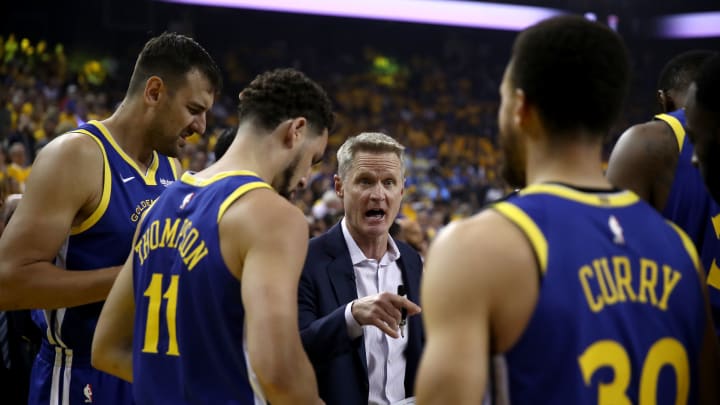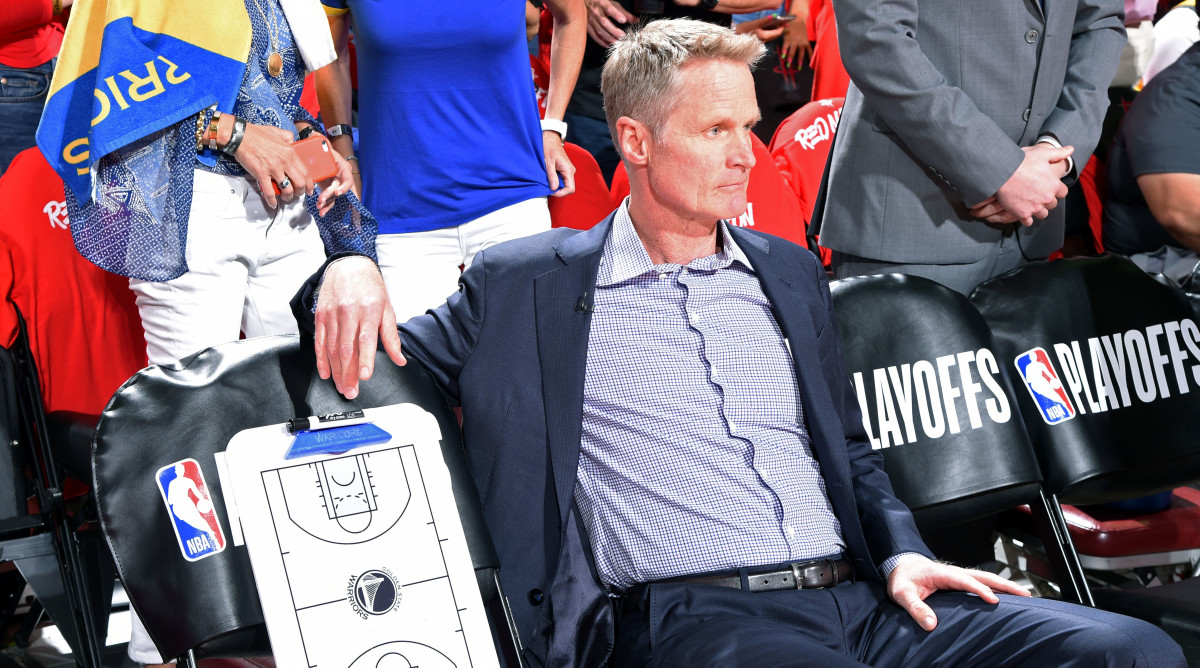Steve Kerr and the Warriors Are Finding More Strength in Numbers Than Ever

Every playoff series is a world all its own, and within the world of the Western Conference finals, Steve Kerr saw opportunity. “This series feels like it's a series where we can play more people,” Kerr said after Game 1 of what would be a four-game sweep of the Trail Blazers. “It's a different matchup, and I think that what you saw tonight is what we'd like to get to every night if we can in terms of [playing] 10, 11 guys.” Those estimates turned out to be conservative. The series tightened following Game 1, but Kerr only further loosened his rotation—playing 12 Warriors in Games 2 and 3 before the absence of Andre Iguodala forced him to pare back down to 11.
In the end, every single available player logged meaningful minutes in the conference finals. Only one Warrior (Andrew Bogut) was a net-negative in the series—one that Portland led in majority. Damian Jones, who missed the bulk of the regular season with a torn pectoral muscle, actually started a playoff game with a trip to the Finals on the line, a dynastic flex if there ever was one. Jacob Evans jumped into the second quarter of the series’ closeout game for his first minutes outside of garbage time. He guarded Damian Lillard. When Game 4 pushed to overtime, it was Alfonzo McKinnie and Kevon Looney who came up with two of Golden State’s three made shots in the period. It was like something out of a Kerr fever dream.

But Golden State’s playoff rotation wasn’t always this way, which brings into question whether it will be again when a title is at stake. Until Durant’s injury, Kerr was intensely selective with who he would even put on the floor against the Rockets. Some of that was owed to the matchup (there’s nowhere to hide against an iso-heavy offense that knows how to pick its targets), some to the slimmer margin for error. With the series at its tightest, Kerr seemed to trust just three reserves: Looney, Shaun Livingston, and—in minimal stints—McKinnie. A Finals series against either Milwaukee or Toronto would visit a similar premise, albeit with new perspective.
“Houston puts so much pressure on you in isolation that, frankly, we just decided to stick with our best defenders over our first five games,” Kerr said in the wake the Warriors’ series against the Rockets. “Obviously, injuries forced us to use the bench. I probably should have used them earlier. Over the years, we've played a lot of people. We like to use our bench. We've talked about 'strength in numbers.’ But the coach wasn't doing much of that in the first five games.”
Considering how the reserves have rewarded Kerr’s investment since, it would be surprising to see them marginalized in quite the same way. This is the coach Kerr wants to be: the kind not only to get the most out of Stephen Curry and Draymond Green, but also Quinn Cook and Jonas Jerebko. The circumstances of the Finals could complicate that leaning but won’t erase it; even if Durant and Iguodala are able to play from the outset of the championship series, it’s fair to expect Kerr to invest further in his bench. Consider the returns. Klay Thompson was the only Warrior to average more than 40 minutes a game in the conference finals, which kept Curry and Green, in particular, fresh for when it mattered most. Different players are maximized in different ways. When your role involves sprinting around the floor non-stop to freak out the defense, simply playing more could be counterproductive. Ditto for the point forward asked to be everywhere at once on defense.
With Durant’s healthy return would come a change in style that could alleviate that need, while also reshaping the rotation. The reason Jones and Jordan Bell started games in the conference finals in the first place was because Durant didn’t. There are simply fewer center minutes to go around when the Warriors have a seven-foot superstar in the mix, just as there will be fewer for the wings when Iguodala comes back. These are huge variables to a playing rotation, though both still leave room for Golden State to err on the side of depth. There’s nothing left to rest for at this stage in the playoffs, but that alone isn’t enough cause to push a star’s minutes without reason. When a player plays can be just as impactful as how much.
“It was a good series for the bench,” Kerr said of the conference finals. “They did a fantastic job, and we, I think, mixed and matched, and tried to find combinations that worked.”
Those combinations apply to both lineups involved. Milwaukee, for example, has yet to play Giannis Antetokounmpo for 40 or more minutes in any regulation game in these playoffs. If that trend holds, there could be eight to 10 minutes a night where the Warriors could push a lead (or cut a deficit) while leaning on reserves. It’s proven to be offense enough to put Curry on the floor with essentially any available role players, provided they play hard and with discipline. So line up Antetokounmpo’s potential rests with minutes for Jerebko, McKinnie, or even Bogut. Toronto’s Kawhi Leonard would be challenging in a different way, though perhaps the matchup with the Raptors might allow a few more minutes from Bogut for the simple reason that Marc Gasol and Serge Ibaka, while capable shooters, won’t pull up with the same abandon as Milwaukee’s Brook Lopez.

There are so many microdynamics at work that could dictate how the Warriors choose to dole out their minutes. Where the Bucks are concerned: If Golden State were to guard the shaky-shooting Eric Bledsoe with Green (as Toronto has done at times with Pascal Siakam), what opportunities for minutes might that open up? A player like Cook might also be more viable against the Bucks, given the shelter of their three-guard lineups. Even though Antetokounmpo attacks in isolation in a similar way to Harden, the Bucks aren’t quite so adept at controlling the matchup in front of him—and the Warriors are among the best at counter-switching their way out of danger. That could leave room for some Warrior lineups that seem vulnerable to overperform. Looney would probably play closer to the 27.5 minutes he averaged in the conference finals than his 18.2 in the semis; there’s nothing more important against Milwaukee than for a rim protector to also be mobile. It could be a Jordan Bell kind of series for much the same reason.
As for the Raptors: How the Warriors choose to defend Leonard could trigger some slight changes in the substitution pattern. Assuming that Iguodala were to get first crack at Kawhi, would Thompson be his second or would Durant? Leonard is dangerous enough that Golden State could stagger its best defenders accordingly to make sure they’re never caught without. The starts of the second and fourth quarters could be a fascinating battleground, as simplified offenses built around Leonard and Durant (who had filled this spot since DeMarcus Cousins’ injury) square off. If their minutes overlap, Siakam has the potential to play Jerebko out of the series. The likely Warrior response would be to play even smaller, manipulating matchups accordingly so that one of Green or KD would slide over to check Siakam. Both Livingston and McKinnie should match up well with the Raptor wings (Kawhi excluded), steadying their roles and biding time for the starters when needed.
There’s a lot to unpack, and another four days—at the earliest—before the Warriors actually know who they’ll play next. Those days in limbo are a video coordinator’s Olympics. Golden State will pore through the tape of both potential opponents for every edge it can find—in search of not only where it might find an extra basket, but an extra minute for some situationally helpful reserve.
